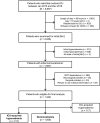Intensive care unit-acquired hyponatremia in critically ill medical patients
- PMID: 32616002
- PMCID: PMC7333267
- DOI: 10.1186/s12967-020-02443-4
Intensive care unit-acquired hyponatremia in critically ill medical patients
Abstract
Background: Previous research has focused on intensive care unit (ICU)-acquired hypernatremia; however, ICU-acquired hyponatremia has frequently been overlooked and has rarely been studied in surgical or mixed ICUs. The aim of this study is to investigate the incidence of ICU-acquired hyponatremia, the risk factors associated with its development, and its impact on outcomes in critically ill medical patients.
Methods: We conducted a retrospective cohort study based on the prospective registry of all critically ill patients admitted to the medical ICU from January 2015 to December 2018. Baseline characteristics and management variables were compared between ICU-acquired hyponatremia and normonatremia patients.
Results: Of 1342 patients with initial normonatremia, ICU-acquired hyponatremia developed in 217 (16.2%) patients and ICU-acquired hypernatremia developed in 117 (8.7%) patients. The Sequential Organ Failure Assessment (8.0 vs 7.0, P = 0.009) and Simplified Acute Physiology Score 3 scores (55.0 vs 51.0, P = 0.005) were higher in ICU-acquired hyponatremia patients compared with normonatremia patients. Baseline sodium (137.0 mmol/L vs 139.0 mmol/L, P < 0.001), potassium (4.2 mmol/L vs 4.0 mmol/L, P = 0.001), and creatinine (0.98 mg/dL vs 0.88 mg/dL, P = 0.034) levels were different between the two groups. Net volume balance over first 3 days was higher in ICU-acquired hyponatremia patients (19.4 mL/kg vs 11.5 mL/kg, P = 0.004) and was associated with the development of ICU-acquired hyponatremia (adjusted odds ratio, 1.004; 95% confidence interval, 1.002-1.007; P = 0.001). ICU mortality was similar in both groups (15.2% vs. 14.4%, P = 0.751), but renal replacement therapy was more commonly required in ICU-acquired hyponatremia patients (13.4% vs 7.4%, P = 0.007).
Conclusions: ICU-acquired hyponatremia is not uncommon in critically ill medical patients. Increased volume balance is associated with its development. ICU-acquired hyponatremia is related to increased use of renal replacement therapy but not to mortality.
Keywords: Acute kidney injury; Critical care; Diseases category; Hyponatremia; Intensive care unit.
Conflict of interest statement
The authors declare that they have no competing interests.
Figures
References
-
- Darmon M, Diconne E, Souweine B, Ruckly S, Adrie C, Azoulay E, Clec’h C, Garrouste-Orgeas M, Schwebel C, Goldgran-Toledano D, Khallel H, Dumenil AS, Jamali S, Cheval C, Allaouchiche B, Zeni F, Timsit JF. Prognostic consequences of borderline dysnatremia: pay attention to minimal serum sodium change. Crit Care. 2013;17:R12. doi: 10.1186/cc11937. - DOI - PMC - PubMed
Publication types
MeSH terms
LinkOut - more resources
Full Text Sources



